- Joined
- Feb 15, 2022
- Posts
- 506
- Qantas
- Platinum
- Virgin
- Platinum
- Star Alliance
- Gold
Hello AFF community, long time lurker, first time trip reporter. Flew ANA 789 economy on a ski trip to Japan a little while ago, and decided to review the SYD - HND leg blogger-style, for mainly the benefit of my friends and family, who encouraged me to post it. Any feedback, comments and questions on everything is welcome, of course  Please bear in mind that this was written for the benefit of the somewhat uninitiated, so things that may seem simple to the more experienced members here are most assuredly not, speaking from personal experience. Enjoy!
Please bear in mind that this was written for the benefit of the somewhat uninitiated, so things that may seem simple to the more experienced members here are most assuredly not, speaking from personal experience. Enjoy!
ANA 787-9 Economy - Sydney to Tokyo Review
TLDR: If you’re willing to pay a premium for direct flights, ANA’s 787-9 offers an extremely competitive product for economy, with efficient service and a fantastic amount of legroom making the flight fairly comfortable and enjoyable (for economy). However, the food options offered were fairly limited, and the cabin was kept very warm.
How and why I booked my ANA flight
This flight was booked with cash; due to being an unplanned and time-poor snow trip meant it was fairly expensive. It is worth noting that on the Sydney – Tokyo Haneda leg, ANA offer two flights a day, a redeye and day flight, while Qantas offer only overnight, with their partner JAL flying during the day. This is changed on the Tokyo-Sydney leg, with JAL and Qantas both flying overnight, (ANA again have the two options).
Thus, to minimize the time wasted by flying during the day, it came down to Qantas vs ANA; with Qantas being about $600 more expensive, ANA was the logical choice. Important to mention that ANA do offer 2 free bags and complimentary meals, although seat selection is a fee.
Sydney Airport departure experience
After arriving at Sydney airport about 3.5 hours before the flight (one of those people, I know) I lined up to check in my bags, although there was a lengthy queue formed even 30min before check-in opened.
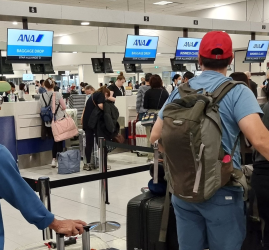
Sydney Airport Check-in Area
The check-in agent asked about the Visit Japan Website details, which while not mandatory to be completed prior to entry to Japan, I would recommend doing at least before you board. Also worth stating that I was taking skis with me, which are simply counted as one piece of luggage, which the gate agent weighed, tagged and told me to drop off at oversize baggage. It was then off to security and customs.
Although I arrived early enough to grab a bite to eat, most of the airport restaurants had closed by 7:30pm, leaving limited food options. As a result, and probably horrifying for some people, I was looking forward to airplane food.
Boarding was scheduled to begin at 9.05pm, with those needing special assistance being asked to board first. ANA boards by group, of which there were five, with Star Alliance elite members and business class passengers asked to board first. As a middle-seat bound economy passenger (pleb) sitting towards the back of the plane, I was naturally in the last boarding group . The use of groups that were enforced by the gate agents did make for an efficient process though.
. The use of groups that were enforced by the gate agents did make for an efficient process though.
The details of the flight are listed below:
All Nippon Airways (ANA) Flight NH880
Sydney (SYD) – Tokyo Haneda (HND)
Departure: 9:35PM
Arrival: 5:10AM
Duration: 9hr35mins
Aircraft: Boeing 787-9
Seat: 32J (Economy)
ANA 787 economy hard product
As one of the last onboard on a completely full economy cabin, it was a little chaotic, although there was still enough room in the overhead bins for my carry-on. ANA’s 787's economy cabin follows the standard 3-3-3 layout, with adjustable headrests, and a small leg-rest attached to the bottom of the seats in front, although this seemed a bit useless. The colour scheme is not anything to get excited about, although the padding was decent.
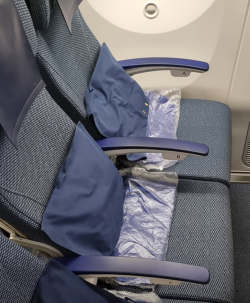
ANA 787 Economy Seats
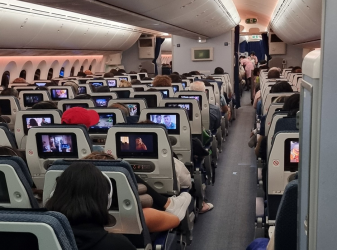
ANA 787 Economy Cabin
Despite the seats being a bit narrow, the legroom was fantastic, at 34 inches of pitch, enough for my 5'11 frame to fully stretch out and relax without bumping my knees! For context, Jetstar domestic economy seating gives you 28 inches of pitch between seats, while Qantas sits at 30-32. So, to have 34 inches of pitch, in an age where airlines are prioritising cash over comfort, is fantastic.
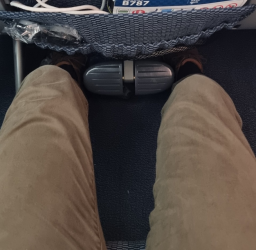
ANA 787 Economy Legroom
I will point out that there were no individual air nozzles, and the cabin temperature was kept too warm for my liking, meaning I woke up sweaty, although this certainly wasn’t helped by the clothes I was wearing in anticipation of the 4 degrees celcius waiting for me in Tokyo!
Overall, the seating was really comfortable for economy class, although I would’ve personally appreciated a cooler cabin.
ANA 787 economy entertainment and amenities
Waiting at my seat as well was a thin blanket, which was not necessary considering the cabin temperature, and a pillow. Disposable headphones were also provided.
The in-flight entertainment system was solid without being spectacular, certainly more than enough for an overnight flight. The screen itself was touchscreen, although there was an old-fashioned remote to use if necessary. The touchscreen was very responsive and provided a good quality picture, although was a little small. Underneath the screen was a 3.5mm jack for audio, meaning you can plug in your own headphones, and a USB-A port. There was a decent selection of both English and Japanese films, including some older films as well as some newer releases.
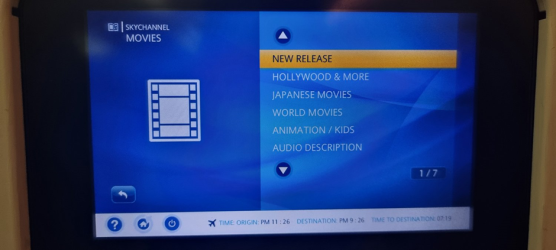
ANA 787 Economy IFE Screen
In regards to other amenities, there were 2 universal AC power outlets for the row, located at the base of the seat. There was also Wi-Fi offered on the flight, via Panasonic, with the pricing being 6.95 USD for 30min, 16.95 USD for 3 hours, or 21.95 USD for the full flight.
I purchased the 30min plan, to test it out. On the face of it, the Wi-Fi pricing seems a little steep, but tolerable, especially considering there are no data caps. However, it was quite slow, barely able to load emails, with a speed test measuring 1.1 Mb download and 0.42 Mb upload.
ANA 787 economy food and service
Approximately 1 hour into the flight, the meal service commenced, with passengers being promptly handed menu cards to decide between chicken or beef options.
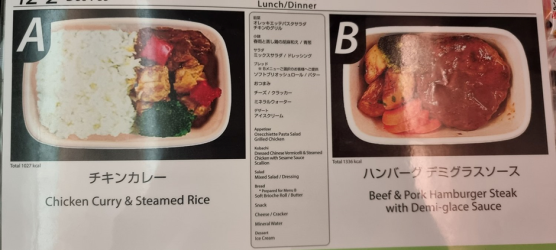
ANA 787 Economy Menu
I opted for the Japanese chicken curry, which was accompanied by an array of side dishes. The person sitting next to me chose the beef, which smelled horrendous, and in his words was “one of the worst things I’ve put in my mouth”. Just FYI
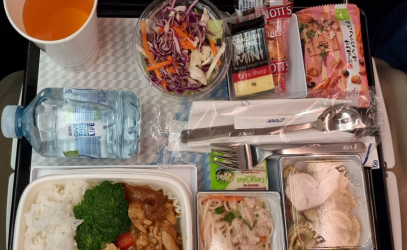
ANA 787 Economy Meal
To me at least, the curry was flavourful, and I was quite satiated after finishing my meal – not a surprise, given the generous amount of food served. A choice of juice, red or white wine, or beer was offered, while sake and soft drinks were not available.
About 1 hour after dinner, dessert was served – a vanilla ice cream by Maggie Beer (yes, any ice cream is worth a photo)
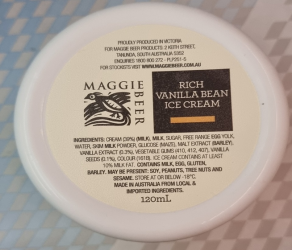
ANA 787 Economy Dessert
Upon finishing dessert, breakfast for the next morning was handed out. Personally, I found it was underwhelming, consisting of a small bag of cake, a Tim-Tam and muesli bar.
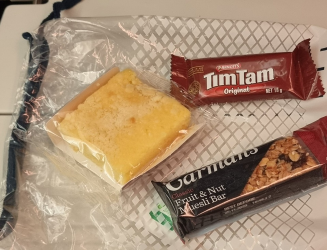
ANA 787 Economy Breakfast
This snack service would have been more appreciated had the cabin remained dark until closer to landing; however, the cabin lights were switched on 1.5 hours before arrival, meaning I was both more tired and hungry the next day, especially as the cabin lights weren’t turned off until about 3 hours into the flight to begin with, leaving under 5 hours of sleep time, on a late departure flight.
Despite this (minor) issue, the flight crew's service was efficient and highly professional throughout the journey, with limited interactions required on the overnight flight.
Tokyo Haneda arrival experience
Disembarkation of the aircraft was orderly, although as I was sitting towards the rear of the plane I was one of the last off. Arrival cards were distributed before landing, where they and my Visit Japan Website QR code was checked before proceeding through to immigration. It took about 30min to pass immigration, although I had to wait another 30min for my checked bags, although this did include oversized luggage. Haneda airport is attached to the Tokyo monorail, which was a 15min ride to Hamamatsucho station, which gets you onto either the JR network or the Tokyo Subway. From there, a quick ride on the JR line to Tokyo Central, and then a Shinkansen to the snow!
Final thoughts
Overall, ANA’s 787 economy product is a great way to travel to Tokyo. The hard product is excellent, with industry-leading leg room, and an overall comfortable, decently padded seat. The dinner service was tasty, and the service throughout was extremely professional. The only, minor, complaints are more personal preference, as I would prefer to either maximise sleep or be full, and a cooler cabin, both of which just didn’t happen on this flight.
ANA 787-9 Economy - Sydney to Tokyo Review
TLDR: If you’re willing to pay a premium for direct flights, ANA’s 787-9 offers an extremely competitive product for economy, with efficient service and a fantastic amount of legroom making the flight fairly comfortable and enjoyable (for economy). However, the food options offered were fairly limited, and the cabin was kept very warm.
How and why I booked my ANA flight
This flight was booked with cash; due to being an unplanned and time-poor snow trip meant it was fairly expensive. It is worth noting that on the Sydney – Tokyo Haneda leg, ANA offer two flights a day, a redeye and day flight, while Qantas offer only overnight, with their partner JAL flying during the day. This is changed on the Tokyo-Sydney leg, with JAL and Qantas both flying overnight, (ANA again have the two options).
Thus, to minimize the time wasted by flying during the day, it came down to Qantas vs ANA; with Qantas being about $600 more expensive, ANA was the logical choice. Important to mention that ANA do offer 2 free bags and complimentary meals, although seat selection is a fee.
Sydney Airport departure experience
After arriving at Sydney airport about 3.5 hours before the flight (one of those people, I know) I lined up to check in my bags, although there was a lengthy queue formed even 30min before check-in opened.

Sydney Airport Check-in Area
The check-in agent asked about the Visit Japan Website details, which while not mandatory to be completed prior to entry to Japan, I would recommend doing at least before you board. Also worth stating that I was taking skis with me, which are simply counted as one piece of luggage, which the gate agent weighed, tagged and told me to drop off at oversize baggage. It was then off to security and customs.
Although I arrived early enough to grab a bite to eat, most of the airport restaurants had closed by 7:30pm, leaving limited food options. As a result, and probably horrifying for some people, I was looking forward to airplane food.
Boarding was scheduled to begin at 9.05pm, with those needing special assistance being asked to board first. ANA boards by group, of which there were five, with Star Alliance elite members and business class passengers asked to board first. As a middle-seat bound economy passenger (pleb) sitting towards the back of the plane, I was naturally in the last boarding group
The details of the flight are listed below:
All Nippon Airways (ANA) Flight NH880
Sydney (SYD) – Tokyo Haneda (HND)
Departure: 9:35PM
Arrival: 5:10AM
Duration: 9hr35mins
Aircraft: Boeing 787-9
Seat: 32J (Economy)
ANA 787 economy hard product
As one of the last onboard on a completely full economy cabin, it was a little chaotic, although there was still enough room in the overhead bins for my carry-on. ANA’s 787's economy cabin follows the standard 3-3-3 layout, with adjustable headrests, and a small leg-rest attached to the bottom of the seats in front, although this seemed a bit useless. The colour scheme is not anything to get excited about, although the padding was decent.

ANA 787 Economy Seats

ANA 787 Economy Cabin
Despite the seats being a bit narrow, the legroom was fantastic, at 34 inches of pitch, enough for my 5'11 frame to fully stretch out and relax without bumping my knees! For context, Jetstar domestic economy seating gives you 28 inches of pitch between seats, while Qantas sits at 30-32. So, to have 34 inches of pitch, in an age where airlines are prioritising cash over comfort, is fantastic.

ANA 787 Economy Legroom
I will point out that there were no individual air nozzles, and the cabin temperature was kept too warm for my liking, meaning I woke up sweaty, although this certainly wasn’t helped by the clothes I was wearing in anticipation of the 4 degrees celcius waiting for me in Tokyo!
Overall, the seating was really comfortable for economy class, although I would’ve personally appreciated a cooler cabin.
ANA 787 economy entertainment and amenities
Waiting at my seat as well was a thin blanket, which was not necessary considering the cabin temperature, and a pillow. Disposable headphones were also provided.
The in-flight entertainment system was solid without being spectacular, certainly more than enough for an overnight flight. The screen itself was touchscreen, although there was an old-fashioned remote to use if necessary. The touchscreen was very responsive and provided a good quality picture, although was a little small. Underneath the screen was a 3.5mm jack for audio, meaning you can plug in your own headphones, and a USB-A port. There was a decent selection of both English and Japanese films, including some older films as well as some newer releases.

ANA 787 Economy IFE Screen
In regards to other amenities, there were 2 universal AC power outlets for the row, located at the base of the seat. There was also Wi-Fi offered on the flight, via Panasonic, with the pricing being 6.95 USD for 30min, 16.95 USD for 3 hours, or 21.95 USD for the full flight.
I purchased the 30min plan, to test it out. On the face of it, the Wi-Fi pricing seems a little steep, but tolerable, especially considering there are no data caps. However, it was quite slow, barely able to load emails, with a speed test measuring 1.1 Mb download and 0.42 Mb upload.
ANA 787 economy food and service
Approximately 1 hour into the flight, the meal service commenced, with passengers being promptly handed menu cards to decide between chicken or beef options.

ANA 787 Economy Menu
I opted for the Japanese chicken curry, which was accompanied by an array of side dishes. The person sitting next to me chose the beef, which smelled horrendous, and in his words was “one of the worst things I’ve put in my mouth”. Just FYI

ANA 787 Economy Meal
To me at least, the curry was flavourful, and I was quite satiated after finishing my meal – not a surprise, given the generous amount of food served. A choice of juice, red or white wine, or beer was offered, while sake and soft drinks were not available.
About 1 hour after dinner, dessert was served – a vanilla ice cream by Maggie Beer (yes, any ice cream is worth a photo)

ANA 787 Economy Dessert
Upon finishing dessert, breakfast for the next morning was handed out. Personally, I found it was underwhelming, consisting of a small bag of cake, a Tim-Tam and muesli bar.

ANA 787 Economy Breakfast
This snack service would have been more appreciated had the cabin remained dark until closer to landing; however, the cabin lights were switched on 1.5 hours before arrival, meaning I was both more tired and hungry the next day, especially as the cabin lights weren’t turned off until about 3 hours into the flight to begin with, leaving under 5 hours of sleep time, on a late departure flight.
Despite this (minor) issue, the flight crew's service was efficient and highly professional throughout the journey, with limited interactions required on the overnight flight.
Tokyo Haneda arrival experience
Disembarkation of the aircraft was orderly, although as I was sitting towards the rear of the plane I was one of the last off. Arrival cards were distributed before landing, where they and my Visit Japan Website QR code was checked before proceeding through to immigration. It took about 30min to pass immigration, although I had to wait another 30min for my checked bags, although this did include oversized luggage. Haneda airport is attached to the Tokyo monorail, which was a 15min ride to Hamamatsucho station, which gets you onto either the JR network or the Tokyo Subway. From there, a quick ride on the JR line to Tokyo Central, and then a Shinkansen to the snow!
Final thoughts
Overall, ANA’s 787 economy product is a great way to travel to Tokyo. The hard product is excellent, with industry-leading leg room, and an overall comfortable, decently padded seat. The dinner service was tasty, and the service throughout was extremely professional. The only, minor, complaints are more personal preference, as I would prefer to either maximise sleep or be full, and a cooler cabin, both of which just didn’t happen on this flight.
Last edited:
















